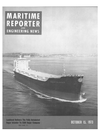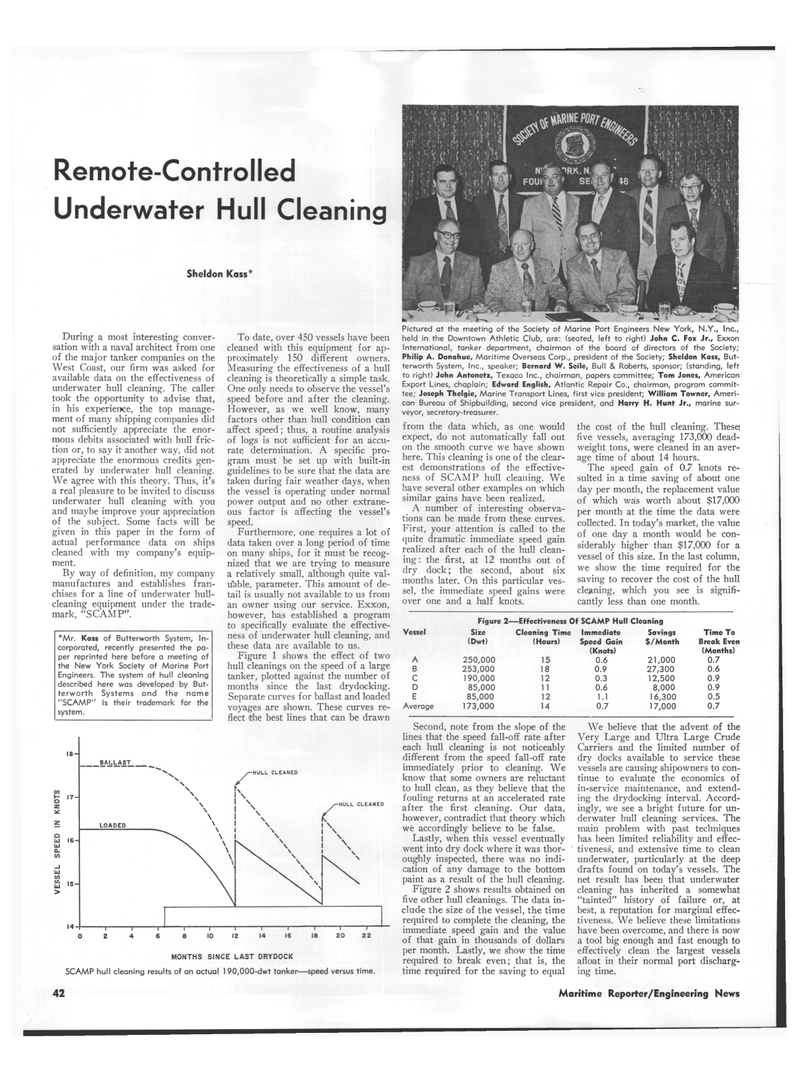
Page 32: of Maritime Reporter Magazine (October 15, 1973)
Read this page in Pdf, Flash or Html5 edition of October 15, 1973 Maritime Reporter Magazine
Remote-Controlled
Underwater Hull Cleaning
Sheldon Kass*
Pictured at the meeting of the Society of Marine Port Engineers New York, N.Y., Inc., held in the Downtown Athletic Club, are: (seated, left to right) John C. Fox Jr., Exxon
International, tanker department, chairman of the board of directors of the Society;
Philip A. Donahue, Maritime Overseas Corp., president of the Society; Sheldon Kass, But- terworth System, Inc., speaker; Bernard W. Seile, Bull & Roberts, sponsor; (standing, left to right) John Antonetz, Texaco Inc., chairman, papers committee; Tom Jones, American
Export Lines, chaplain; Edward English, Atlantic Repair Co., chairman, program commit- tee; Joseph Thelgie, Marine Transport Lines, first vice president; William Towner, Ameri- can Bureau of Shipbuilding, second vice president, and Harry H. Hunt Jr., marine sur- veyor, secretary-treasurer.
During a most interesting conver- sation with a naval architect from one of the major tanker companies on the
West Coast, our firm was asked for available data on the effectiveness of underwater hull cleaning. The caller took the opportunity to advise that, in his experience, the top manage- ment of many shipping companies did not sufficiently appreciate the enor- mous debits associated with hull fric- tion or, to say it another way, did not appreciate the enormous credits gen- erated by underwater hull cleaning.
We agree with this theory. Thus, it's a real pleasure to be invited to discuss underwater hull cleaning with you and maybe improve your appreciation of the subject. Some facts will be given in this paper in the form of aotual performance data on ships cleaned with my company's equip- ment.
By way of definition, my company manufactures and establishes fran- chises for a line of underwater hull- cleaning equipment under the trade- mark, "SCAMP". *Mr. Kass of Butterworth System, In- corporated, recently presented the pa- per reprinted here before a meeting of the New York Society of Marine Port
Engineers. The system of hull cleaning described here was developed by But- terworth Systems and the name "SCAMP" is their trademark for the system. 18-
To date, over 450 vessels have been cleaned with this equipment for ap- proximately 150 different owners.
Measuring the effectiveness of a hull cleaning is theoretically a simple task.
One only needs to observe the vessel's speed before and after the cleaning.
However, as we well know, many factors other than hull condition can affect speed; thus, a routine analysis of logs is not sufficient for an accu- rate determination. A specific pro- gram must be set up with built-in guidelines to be sure that the data are taken during fair weather days, when the vessel is operating under normal power output and no other extrane- ous factor is affecting the vessel's speed.
Furthermore, one requires a lot of data taken over a long period of time on many ships, for it must be recog- nized that we are trying to measure a relatively small, although quite val- uable, parameter. This amount of de- tail is usually not available to us from an owner using our service. Exxon, however, has established a program to specifically evaluate the effective- ness of underwater hull cleaning, and these data are available to us.
Figure 1 shows the effect of two hull cleanings on the speed of a large tanker, plotted against the number of months since the last drydocking.
Separate curves for ballast and loaded voyages are shown. These curves re- flect the best lines that can be drawn from the data which, as one would expect, do not automatically fall out on the smooth curve we have shown here. This cleaning is one of the clear- est demonstrations of the effective- ness of SCAMP hull cleaning. We have several other examples on which similar gains have been realized.
A number of interesting observa- tions can be made from these curves.
First, your attention is called to the quite dramatic immediate speed gain realized after each of the hull clean- ing: the first, at 12 months out of dry dock; the second, about six months later. On this particular ves- sel, the immediate speed gains were over one and a half knots.
Vessel
A
B
C
D
E
Average
Second, note from the slope of the lines that the speed fall-off rate after each hull cleaning is not noticeably different from the speed fall-off rate immediately prior to cleaning. We know that some owners are reluctant to hull clean, as they believe that the fouling returns at an accelerated rate after the first cleaning. Our data, however, contradict that theory which we accordingly believe to be false.
Lastly, when this vessel eventually went into dry dock where it was thor- oughly inspected, there was no indi- cation of any damage to the bottom paint as a result of the hull cleaning.
Figure 2 shows results obtained on five other hull cleanings. The data in- clude the size of the vessel, the time required to complete the cleaning, the immediate speed gain and the value of that gain in thousands of dollars per month. Lastly, we show the time required to break even.; that is, the time required for the saving to equal the cost of the hull cleaning. These! five vessels, averaging 173,00O dead- weight tons, were cleaned in an aver- age time of about 14 hours.
The speed gain of 0.7 knots re- sulted in a time saving of about one day per month, the replacement value of which was worth about $17,000 per month at the time the data were collected. In today's market, the value of one day a month would be con- siderably higher than $17,000 for a vessel of this size. In the last column, we show the time required for the saving to recover the cost of the hull cleaning, which you see is signifi- cantly less than one month.
Time To
Break Even (Months) 0.7 0.6 0.9 0.9 0.5 0.7
We believe that the advent of the
Very Large and Ultra Large Crude
Carriers and the limited number of dry docks available to service these vessels are causing shipowners to con- tinue to evaluate the economics of in-service maintenance, and extend- ing the drydocking interval. Accord- ingly, we see a bright future for un- derwater hull cleaning services. The main problem with past techniques has been limited reliability and effec- ' tiveness, and extensive time to clean underwater, particularly at the deep drafts found on today's vessels. The net result has been that underwater cleaning has inherited a somewhat "tainted" history of failure or, at best, a reputation for marginal effec- tiveness. We believe these limitations have been overcome, and there is now a tool big enough and fast enough to effectively clean the largest vessels afloat in their normal port discharg- ing time.
HULL CLEANED
HULL CLEANED 16 18 20 22
MONTHS SINCE LAST DRYDOCK
SCAMP hull cleaning results of an actual 1 90,000-dwt tanker—speed versus time.
Figure 2—Effectiveness Of SCAMP Hull Cleaning
Size Cleaning Time Immediate Savings (Dwt) (Hours) Speed Gain $/Month (Knots) 250,000 15 0.6 21,000 253,000 18 0.9 27,300 190,000 12 0.3 12,500 85,000 11 0.6 8,000 85,000 12 1.1 16,300 173,000 14 0.7 17,000 14 Maritime Reporter/Engineering News

 31
31

 33
33
